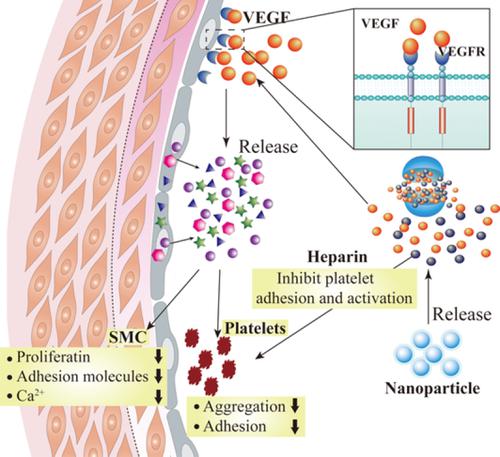当前位置:
X-MOL 学术
›
J. Biomed. Mater. Res. Part A
›
论文详情
Our official English website, www.x-mol.net, welcomes your
feedback! (Note: you will need to create a separate account there.)
Heparin/poly-l-lysine nanoplatform with growth factor delivery for surface modification of cardiovascular stents: The influence of vascular endothelial growth factor loading.
Journal of Biomedical Materials Research Part A ( IF 3.9 ) Pub Date : 2020-02-27 , DOI: 10.1002/jbm.a.36902 Jianying Tan 1 , Yuanyuan Cui 1 , Zheng Zeng 1 , Lai Wei 1 , Li Li 1 , Huanran Wang 1 , Huiyi Hu 1 , Tao Liu 2 , Nan Huang 1 , Junying Chen 1 , Yajun Weng 3
Journal of Biomedical Materials Research Part A ( IF 3.9 ) Pub Date : 2020-02-27 , DOI: 10.1002/jbm.a.36902 Jianying Tan 1 , Yuanyuan Cui 1 , Zheng Zeng 1 , Lai Wei 1 , Li Li 1 , Huanran Wang 1 , Huiyi Hu 1 , Tao Liu 2 , Nan Huang 1 , Junying Chen 1 , Yajun Weng 3
Affiliation

|
The rapid re‐endothelialization of the vascular stent surface is desirable for preventing thrombosis or reducing restenosis. Many biological factors that promote the biological behavior of endothelial cells have been used for the surface modification of stents. Vascular endothelial growth factor (VEGF), which plays an important role in angiogenesis, induces strong vascular growth. In this study, we investigated different VEGF concentrations (50 to 500 ng/ml) to determine the optimum concentration for biocompatibility. First, VEGF‐loaded heparin/poly‐l‐lysine (Hep‐PLL) nanoparticles were created by electrostatic interactions. Then, the VEGF‐loaded nanoparticles were immobilized on dopamine‐coated 316 L stainless steel (SS) surfaces. The physical and chemical properties of the modified surface were characterized and the biocompatibility was evaluated in vitro. The results indicated that the VEGF‐loaded nanoparticles were immobilized successfully on the 316LSS surface, as evidenced by the results of Alcian Blue staining and water contact angle (WCA) measurements. The low platelet adhesion and activation indicated that the modified surfaces had good blood compatibility. The modified surfaces showed a good inhibitory effect on smooth muscle cells, indicating that they inhibited tissue hyperplasia. In addition, the modified surfaces significantly promoted endothelial cell adhesion, proliferation, migration, and biological activity, especially VEGF concentration was 350 ng/ml (NPV350). The optical VEGF concentration of the surface modified Hep‐PLL nanoparticles was 350 ng/ml. The proposed method shows promise for potential applications for cardiovascular devices.
中文翻译:

具有生长因子递送的肝素/聚-l-赖氨酸纳米平台用于心血管支架表面修饰:血管内皮生长因子负载的影响。
血管支架表面的快速再内皮化对于预防血栓形成或减少再狭窄是可取的。许多促进内皮细胞生物学行为的生物因子已被用于支架的表面改性。血管内皮生长因子 (VEGF) 在血管生成中起重要作用,可诱导强烈的血管生长。在这项研究中,我们研究了不同的 VEGF 浓度(50 到 500 ng/ml)以确定生物相容性的最佳浓度。首先,通过静电相互作用产生载有 VEGF 的肝素/聚-l-赖氨酸(Hep-PLL)纳米颗粒。然后,将载有 VEGF 的纳米颗粒固定在多巴胺涂层的 316 L 不锈钢 (SS) 表面上。表征了改性表面的物理和化学性质,并在体外评估了生物相容性。结果表明,载有 VEGF 的纳米粒子成功地固定在 316LSS 表面上,阿尔辛蓝染色和水接触角 (WCA) 测量结果证明了这一点。低血小板粘附和活化表明改性表面具有良好的血液相容性。修饰的表面对平滑肌细胞显示出良好的抑制作用,表明它们抑制了组织增生。此外,改性表面显着促进内皮细胞粘附、增殖、迁移和生物活性,尤其是VEGF浓度为350 ng/ml (NPV350)。表面修饰的 Hep-PLL 纳米粒子的光学 VEGF 浓度为 350 ng/ml。
更新日期:2020-02-27
中文翻译:

具有生长因子递送的肝素/聚-l-赖氨酸纳米平台用于心血管支架表面修饰:血管内皮生长因子负载的影响。
血管支架表面的快速再内皮化对于预防血栓形成或减少再狭窄是可取的。许多促进内皮细胞生物学行为的生物因子已被用于支架的表面改性。血管内皮生长因子 (VEGF) 在血管生成中起重要作用,可诱导强烈的血管生长。在这项研究中,我们研究了不同的 VEGF 浓度(50 到 500 ng/ml)以确定生物相容性的最佳浓度。首先,通过静电相互作用产生载有 VEGF 的肝素/聚-l-赖氨酸(Hep-PLL)纳米颗粒。然后,将载有 VEGF 的纳米颗粒固定在多巴胺涂层的 316 L 不锈钢 (SS) 表面上。表征了改性表面的物理和化学性质,并在体外评估了生物相容性。结果表明,载有 VEGF 的纳米粒子成功地固定在 316LSS 表面上,阿尔辛蓝染色和水接触角 (WCA) 测量结果证明了这一点。低血小板粘附和活化表明改性表面具有良好的血液相容性。修饰的表面对平滑肌细胞显示出良好的抑制作用,表明它们抑制了组织增生。此外,改性表面显着促进内皮细胞粘附、增殖、迁移和生物活性,尤其是VEGF浓度为350 ng/ml (NPV350)。表面修饰的 Hep-PLL 纳米粒子的光学 VEGF 浓度为 350 ng/ml。











































 京公网安备 11010802027423号
京公网安备 11010802027423号